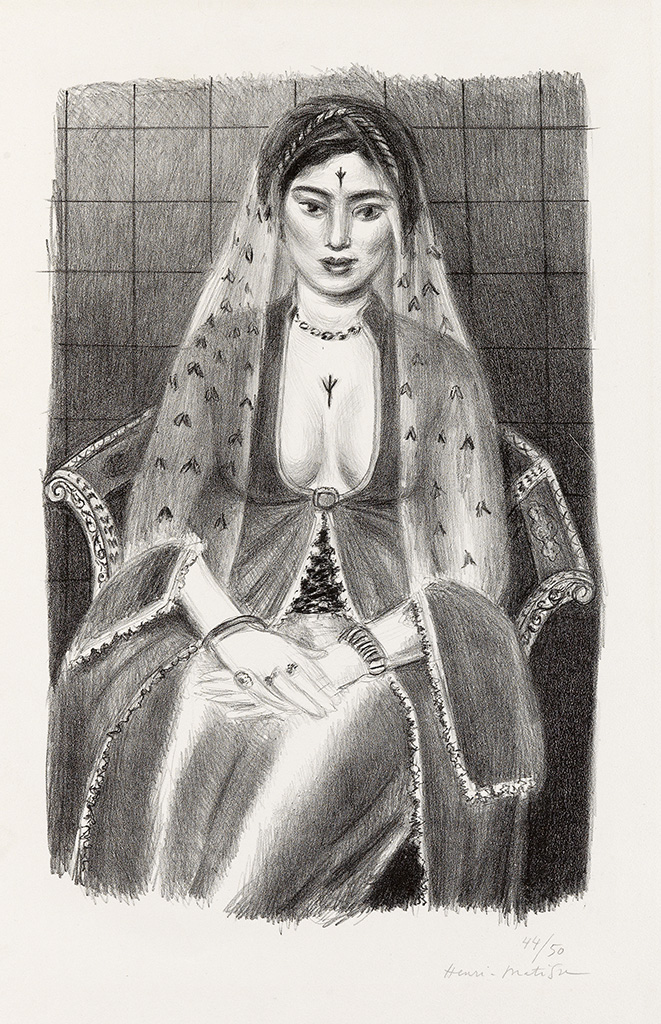Sale 2347 - Lot 375
Unsold
Estimate: $ 50,000 - $ 80,000
HENRI MATISSE
La Persane.
Lithograph, 1929. 448x290 mm; 17 5/8x11 3/8 inches, full margins. Signed and numbered 44/50 in pencil, lower right. A superb, richly-inked and strongly-printed impression of this very scarce, important lithograph.
Born in the north of France to a family of weavers and grain merchants, Matisse (1869-1954) grew up in a rustic, pre-industrial town. In 1889, after passing the bar exam and becoming a law clerk (which he found exceedingly tedious), he was diagnosed with appendicitis. During his convalescence, his mother bought him art supplies and it was only then that he began to paint. He left for Paris in 1891 to begin his formal art education. Matisse went to the traditional schools and was trained in the academic manner, a background evidenced by his early drawings. Nevertheless, he soon began to experiment with the flurry of new styles and movements taking shape at the time, fraternizing with other Post Impressionists and influential contemporaries in Paris, aligning himself with a group of like-minded artists who would become the Fauves.
Matisse and the Fauves met great criticism when they debuted in Paris at the famous Salon d'Automne in 1905. This exhibition gave birth to the moniker, Fauves (meaning "wild beasts"), because of their perceived violent disregard for realistic use of color and form. While he exhibited with other Fauves such as Derain, Vlaminck and Van Dongen, Matisse experienced the lion's share of criticism for his painting Woman with a Hat, 1905. In this early work, Matisse fused Pointillist color theory with Cézanne's rich, painterly impasto in what contemporary critics regarded as a disregard for artistic sanctity.
After his initial adherence to Fauvism, Matisse explored varied styles and themes. In the latter years of his life, after having battled cancer and confinement to a wheelchair in 1941, Matisse focused on collage using paper cutouts (see lot 381). La Persane, considered among Matisse's most important lithographs, marks what is known as his "Nice period," spanning approximately 15 years from around 1917 to 1930, during which he lived in the south of France and focused on portraits of female models dressed in exotic, foreign costumes set before decorative backdrops.
Though primarily known for his paintings and sculptures, Matisse was also a prolific printmaker, producing over 800 individual prints (typically in editions of 25 to 50) from 1900 to 1954. He moved freely between various printmaking techniques and used each as an extension of his drawing style and process. The imagery he created often was repeated forms of reclining nudes, portraits and dancing bodies drawn with elegant and energetic contour lines. For Matisse, printmaking spurred creativity and innovation while also enabling him to produce further works in multiples to satisfy the increasing demand for his art. While Matisse's prints are still relatively under-appreciated next to his paintings and sculptures, their wide dissemination and demand undoubtedly contributed immensely to his position as a preeminent artist of the 20th century. Duhuit 507.
La Persane.
Lithograph, 1929. 448x290 mm; 17 5/8x11 3/8 inches, full margins. Signed and numbered 44/50 in pencil, lower right. A superb, richly-inked and strongly-printed impression of this very scarce, important lithograph.
Born in the north of France to a family of weavers and grain merchants, Matisse (1869-1954) grew up in a rustic, pre-industrial town. In 1889, after passing the bar exam and becoming a law clerk (which he found exceedingly tedious), he was diagnosed with appendicitis. During his convalescence, his mother bought him art supplies and it was only then that he began to paint. He left for Paris in 1891 to begin his formal art education. Matisse went to the traditional schools and was trained in the academic manner, a background evidenced by his early drawings. Nevertheless, he soon began to experiment with the flurry of new styles and movements taking shape at the time, fraternizing with other Post Impressionists and influential contemporaries in Paris, aligning himself with a group of like-minded artists who would become the Fauves.
Matisse and the Fauves met great criticism when they debuted in Paris at the famous Salon d'Automne in 1905. This exhibition gave birth to the moniker, Fauves (meaning "wild beasts"), because of their perceived violent disregard for realistic use of color and form. While he exhibited with other Fauves such as Derain, Vlaminck and Van Dongen, Matisse experienced the lion's share of criticism for his painting Woman with a Hat, 1905. In this early work, Matisse fused Pointillist color theory with Cézanne's rich, painterly impasto in what contemporary critics regarded as a disregard for artistic sanctity.
After his initial adherence to Fauvism, Matisse explored varied styles and themes. In the latter years of his life, after having battled cancer and confinement to a wheelchair in 1941, Matisse focused on collage using paper cutouts (see lot 381). La Persane, considered among Matisse's most important lithographs, marks what is known as his "Nice period," spanning approximately 15 years from around 1917 to 1930, during which he lived in the south of France and focused on portraits of female models dressed in exotic, foreign costumes set before decorative backdrops.
Though primarily known for his paintings and sculptures, Matisse was also a prolific printmaker, producing over 800 individual prints (typically in editions of 25 to 50) from 1900 to 1954. He moved freely between various printmaking techniques and used each as an extension of his drawing style and process. The imagery he created often was repeated forms of reclining nudes, portraits and dancing bodies drawn with elegant and energetic contour lines. For Matisse, printmaking spurred creativity and innovation while also enabling him to produce further works in multiples to satisfy the increasing demand for his art. While Matisse's prints are still relatively under-appreciated next to his paintings and sculptures, their wide dissemination and demand undoubtedly contributed immensely to his position as a preeminent artist of the 20th century. Duhuit 507.

Exhibition Hours
Exhibition Hours
Aliquam vulputate ornare congue. Vestibulum maximus, libero in placerat faucibus, risus nisl molestie massa, ut maximus metus lectus vel lorem.


